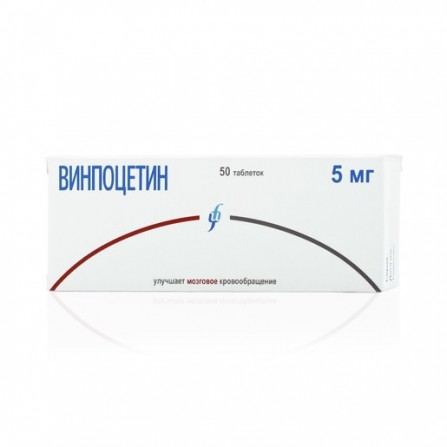Vinpocetine Izvarino pills 5 mg N50
Condition: New product
1000 Items
Rating:
Be the first to write a review!

More info
Active ingredients
Vinpocetine
Release form
Pills
Composition
1 tablet contains: Active ingredient: Vinpocetine 10 mg. Excipients: Magnesium stearate, colloidal silicon dioxide, talc, lactose monohydrate, corn starch.
Pharmacological effect
A means of improving cerebral circulation and brain metabolism. Inhibits phosphodiesterase activity, which contributes to the accumulation of cAMP in tissues. It has a vasodilating effect mainly on the vessels of the brain, which is caused by direct myotropic antispasmodic action. Systemic blood pressure drops slightly. It improves blood circulation and microcirculation in the brain tissues, reduces platelet aggregation, and contributes to the normalization of the rheological properties of blood. It improves the portability of hypoxia by brain cells, facilitating the transport of oxygen to the tissues due to a decrease in the red blood cell affinity for it, enhancing the absorption and metabolism of glucose. Increases the content of catecholamines in brain tissue.
Pharmacokinetics
When ingestion is rapidly absorbed from the gastrointestinal tract. Cmax in plasma is reached in approximately 1 hour. When administered parenterally, Vd is 5.3 L / kg. T1 / 2 is about 5 h.
Indications
Neurology: symptomatic treatment of the effects of ischemic stroke, vascular vertebrobasilar insufficiency, vascular dementia, cerebral arteriosclerosis, post-traumatic, hypertensive encephalopathy. Ophthalmology: chronic vascular diseases of the retina and choroid. Otology: hearing loss of the perceptual type, Meniere's disease, tinnitus. To avoid complications, apply strictly as prescribed by a doctor.
Contraindications
Hypersensitivity to vinpocetine or to any of the components of the drug. Pregnancy, lactation period. Children up to 18 years (due to lack of data).
Precautionary measures
Since the cardiovascular system: transient arterial hypertension, tachycardia; rarely - beats, an increase in time of excitation of the ventricles.
Use during pregnancy and lactation
Contraindicated for use in pregnancy. Data on the safety of use during lactation are not available.
Dosage and administration
Inside, after eating.The course of treatment and the dose is determined by the attending physician. Typically, the daily dose is 15-30 mg (5-10 mg 3 times a day). The initial daily dose is 15 mg. The maximum daily dose of 30 mg. Dose adjustment for the elderly, for violations of the liver or kidneys is not required.
Side effects
The following classifications are used to determine the incidence of side effects of the drug: Very often (≥ 1/10) Often (≥ 1/100 and less than 1/10) Infrequently (≥ 1/1000 and less than 1/100) Rarely (≥ 1/10 000 and less than 1/1000) Very rarely (≥ 1/10 000). From the side of the heart, rarely - ischemia / myocardial infarction, bradycardia, angina pectoris, tachycardia, extrasystole, heart palpitations. very rarely - arrhythmia, atrial fibrillation. On the part of the blood vessels, infrequently - a decrease in blood pressure. rarely - increased blood pressure, a feeling of hot flashes, thrombophlebitis. very rarely - instability of blood pressure. On the other hand, it is rare for the central nervous system to have a headache. rarely - dysgeusia, stupor, hemiparesis, drowsiness, amnesia. very rarely - tremor, spasms. On the part of the organ of vision rarely - swelling of the optic nerve head. very rarely - conjunctival hyperemia. On the part of the organ of hearing and balance, it is not often - vertigo. seldom - hyperacusia, hypoacuse, tinnitus. On the part of the digestive system it is not often - abdominal discomfort, dry mouth, nausea. rarely, dyspepsia, vomiting, constipation, diarrhea, epigastric pain. very rarely - stomatitis, dysphagia. Mental disturbances rarely - sleep disturbances (insomnia, increased sleepiness), anxiety. Very rarely - euphoria, depression. On the side of the blood and lymphatic system rarely - leukopenia, thrombocytopenia. very rarely - anemia, agglutination of erythrocytes. Immunological disorders are very rare - hypersensitivity. Disorders of metabolism and nutrition infrequently - hypercholesterolemia. rarely, decreased appetite, anorexia, diabetes mellitus. On the side of the skin and subcutaneous tissue, rarely - hyperemia of the skin, hyperhidrosis, pruritus, urticaria, skin rash. very rarely - dermatitis. General disorders and disorders at the injection site rarely - asthenia, malaise, burning sensation. very rare - chest discomfort, hypothermia. Laboratory disorders are rare - reduction of blood pressure. rarely - increased blood pressure, hypertriglyceridemia, ECG changes (ST depression, prolongation of the QT interval), eosinopenia, impaired functional hepatic tests.very rarely - leukopenia, leukocytopenia, erythropenia, reduction in thrombin time, increased body weight.
Interaction with other drugs
When applied simultaneously with warfarin, a small decrease in the anticoagulant effect of warfarin has been reported. With simultaneous parenteral administration of vinpocetine and heparin, there may be an increased risk of bleeding.
special instructions
With caution used internally for arrhythmias, angina, with unstable blood pressure and low vascular tone. Parenteral, as a rule, is used in acute cases to improve the clinical picture, then move to ingestion. In chronic diseases, Vinpocetine is taken orally. In hemorrhagic cerebral stroke, parenteral administration of vinpocetine is allowed only after the reduction of acute events (usually 5-7 days).




